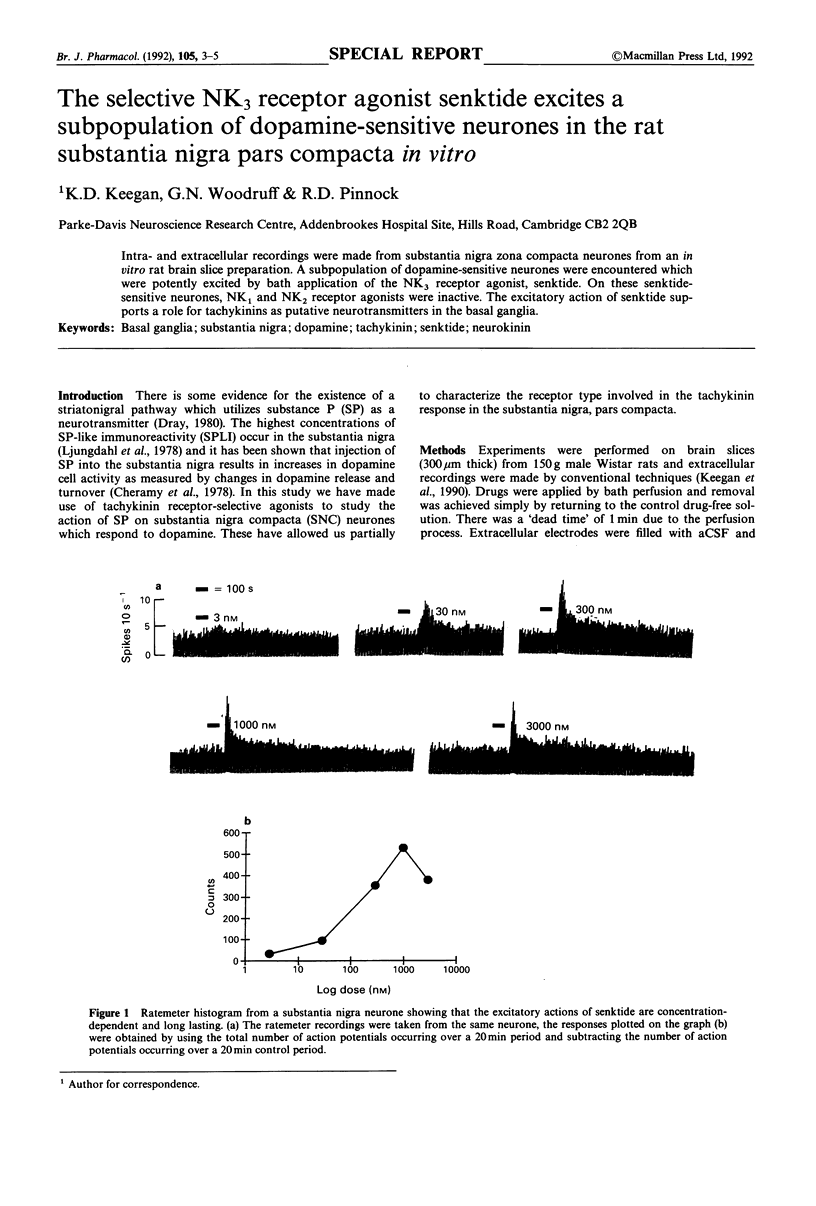Abstract
Intra- and extracellular recordings were made from substantia nigra zona compacta neurones from an in vitro rat brain slice preparation. A subpopulation of dopamine-sensitive neurones were encountered which were potently excited by bath application of the NK3 receptor agonist, senktide. On these senktide-sensitive neurones, NK1 and NK2 receptor agonists were inactive. The excitatory action of senktide supports a role for tachykinins as putative neurotransmitters in the basal ganglia.
Full text
PDF


Selected References
These references are in PubMed. This may not be the complete list of references from this article.
- Cheramy A., Michelot R., Leviel V., Nieoullon A., Glowinski J., Kerdelhue B. Effect of the immunoneutralization of substance P in the cat substantia nigra on the release of dopamine from dendrites and terminals of dopaminergic neurons. Brain Res. 1978 Oct 27;155(2):404–408. doi: 10.1016/0006-8993(78)91038-7. [DOI] [PubMed] [Google Scholar]
- Dam T. V., Escher E., Quirion R. Visualization of neurokinin-3 receptor sites in rat brain using the highly selective ligand [3H]senktide. Brain Res. 1990 Jan 1;506(1):175–179. doi: 10.1016/0006-8993(90)91218-6. [DOI] [PubMed] [Google Scholar]
- Dray A. The physiology and pharmacology of mammalian basal ganglia. Prog Neurobiol. 1980;14(4):221–335. doi: 10.1016/0301-0082(80)90017-9. [DOI] [PubMed] [Google Scholar]
- Kanazawa I., Ogawa T., Kimura S., Munekata E. Regional distribution of substance P, neurokinin alpha and neurokinin beta in rat central nervous system. Neurosci Res. 1984 Dec;2(1-2):111–120. doi: 10.1016/0168-0102(84)90009-9. [DOI] [PubMed] [Google Scholar]
- Ljungdahl A., Hökfelt T., Nilsson G., Goldstein M. Distribution of substance P-like immunoreactivity in the central nervous system of the rat--II. Light microscopic localization in relation to catecholamine-containing neurons. Neuroscience. 1978;3(10):945–976. doi: 10.1016/0306-4522(78)90117-3. [DOI] [PubMed] [Google Scholar]
- Mantyh P. W., Pinnock R. D., Downes C. P., Goedert M., Hunt S. P. Correlation between inositol phospholipid hydrolysis and substance P receptors in rat CNS. 1984 Jun 28-Jul 4Nature. 309(5971):795–797. doi: 10.1038/309795a0. [DOI] [PubMed] [Google Scholar]
- Pinnock R. D., Dray A. Differential sensitivity of presumed dopaminergic and non-dopaminergic neurones in rat substantia nigra to electrophoretically applied substance P. Neurosci Lett. 1982 Apr 16;29(2):153–158. doi: 10.1016/0304-3940(82)90345-7. [DOI] [PubMed] [Google Scholar]
- Pinnock R. D. Neurotensin depolarizes substantia nigra dopamine neurones. Brain Res. 1985 Jul 8;338(1):151–154. doi: 10.1016/0006-8993(85)90258-6. [DOI] [PubMed] [Google Scholar]


